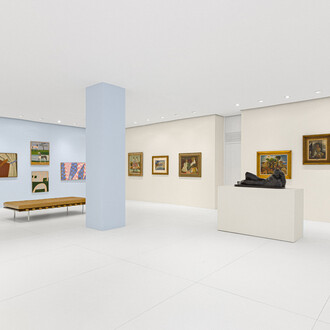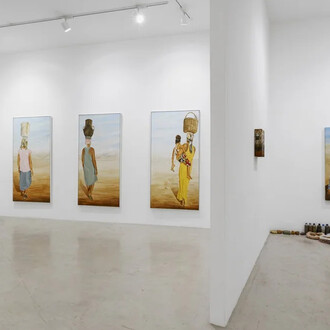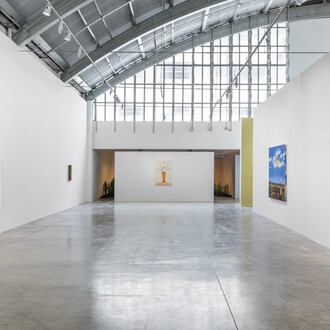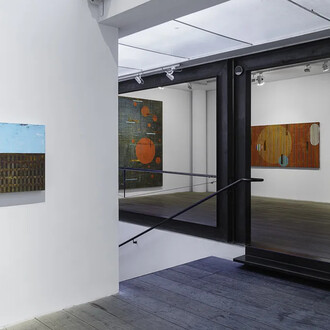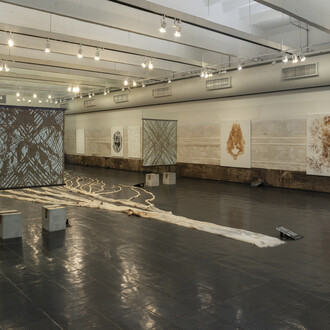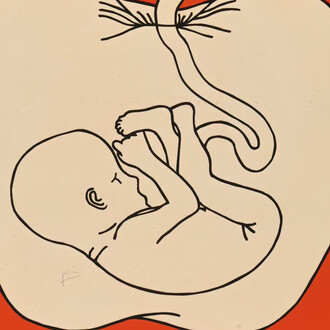Gomide & Co presents, with great enthusiasm, the exhibition Lorenzato: Landscapes. Opening on February 9, 2022, it is the result of a long research that has been carried out since the artist’s first solo show in the gallery space, in 2014. E você nem imagina que Epanimondas sou eu was curated by artists Rivane Neuenschwander and Alexandre da Cunha. The initiative unfolded into national and international exhibitions by Lorenzato, culminating in the solo exhibition Amadeo Luciano Lorenzato, held in 2019 at David Zwirner London.
The exhibition Lorenzato: Landscapes, at Gomide & Co, seeks to revisit Lorenzato’s production based on the artist’s treatment of the landscapes of Minas Gerais (Brazil) and its surroundings, presenting its nature, streets, alleys and characters by employing a stylised, geometric and colourful vocabulary.
Born in 1900 in Belo Horizonte, son of Italian immigrants, he spent his childhood in the newly inaugurated capital city. At the age of 20, he moved with his family to Arsiero, Italy, where he took part in the reconstruction of the city that had been devastated during the 1st World War. In 1925, during the brief period he studied at the Reale Accademia delle Arti in Vicenza, he was introduced to the practice of easel painting. Between 1926 and 1930 he spent time in Rome, where he met the Dutch painter Cornelius Keesman, who became a great observation partner and accompanied him on a bicycle trip through Eastern Europe towards Asia, a project interrupted due to the refusal of Lorenzato’s Italian passport.
In the 1940s, Lorenzato spent some time in Brussels and worked in Paris until his return to Brazil in 1948. In the city of Petrópolis, he continued working in construction, more specifically as a decorative wall painter. In 1949 he brought his wife Emma and their only child Lorenzo to Brazil. In 1956, as a result of an accident at work, Lorenzato retired early at the age of 56. However, the accident that caused his premature retirement did not prevent him from continuing the excursions that stimulated his work in the studio: I leave home, get the paper, make drawings, write down the colours more or less and then, having the sketches, I paint. I have to see the landscape, the colours. If I don’t see, I don’t paint. - Amadeo Luciano Lorenzato, interview granted to Cláudia Gianetti and Thomas Nölle, Belo Horizonte, jul. 1988.
The exhibition Lorenzato: Landscapes gathers around 30 paintings made by the artist between 1969 and 1993 and brings as a common thread his treatment of the landscape. Everything he observed in the countryside or witnessed in the community’s daily life was reinvented in landscapes, still lifes and abstractions charged with movement, as we can see in the painting Untitled (ALL-0236).
Given the vertical orientation of most of his paintings, one could say that Lorenzato was making portraits of landscapes. His Untitled paintings of 1977 and 1976 (ALL-0240, ALL-0223) are natural, idyllic views. Sceneries inhabited by characters in leisure activities, presenting us with a sensitivity towards the quotidian. The paintings instigates us to retrace the artist’s journeys, revisiting a variety of imaginary landscapes; rural, urban, maritime. Figurative or abstract, they emerge from a lived reality, from Lorenzato’s walks, but also awakes a warm, almost nostalgic memory in the spectator.
The way in which Lorenzato imprints texture to his images through grooves made with combs - a remnant of a technique for finishing wood and marble stuccos - signals a sophistication that singularizes his work and distances him from an idea of a “primitive” painter. In Untitled, from 1988 (ALL-0259), the view of Lagoa Santa is incorporated into the Serra da Piedade and the greys and blues merge into a stylised horizon. In this sense, the formal investigation, the minimalism of the forms and the simplicity with which this vocabulary is integrated into the structure of the painting, imprinting movement to its clouds and vegetation, are excellent examples of the grandiosity that Lorenzato’s work claims.
The exhibition also brings a selection of everyday objects that individualizes Lorenzato’s technique and outlines a perspective of his artistic practice based on his distinctive use of tools. Alongside with the canvasses, his combs, brushes, pans, paints and pigments present the gesture of painting based on what their surroundings informs.






![Bruno Munari (1907-1998)
Forchetta parlante, 1958-1991, Ed. 18/20
Garfo torcido sobre madeira
[Bent fork on wood]
15 x 7 x 3 cm [5 7/8 x 2 3/4 x 1 1/8 in.]](http://media.meer.com/attachments/582ae4ad2069da3df8b04376669e19755ef38c25/store/fill/330/330/fddfcc2bc266d3812450a83789a0c87812d6adba2c5fe72080b1c3b22654/Bruno-Munari-1907-1998-Forchetta-parlante-1958-1991-Ed-18-slash-20-Garfo-torcido-sobre-madeira.jpg)
![Bruce Conner (1933-2008)
BREAKAWAY, 1966
Filme 16mm em preto e branco
[Black and white 16mm film]
5 min
BC-0019
Courtesy: The Conner Family Trust, Kohn Gallery and Bergamin & Gomide](http://media.meer.com/attachments/7d07aa708db7f25e05333b5b262166f49883bfa7/store/fill/330/330/839c49e290870e0a9fe994df5e0c140d163ec7ca78a6019e5e8b269855f1/Bruce-Conner-1933-2008-BREAKAWAY-1966-Filme-16mm-em-preto-e-branco-Black-and-white-16mm-film-5.jpg)

